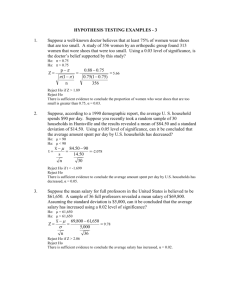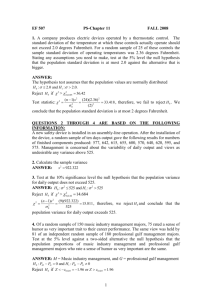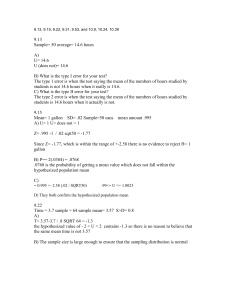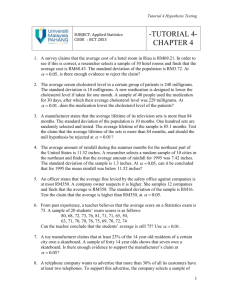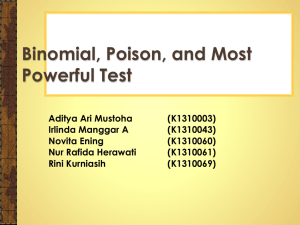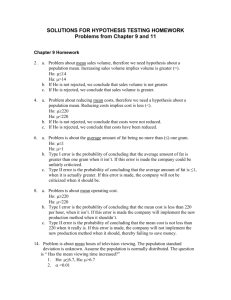Hypothesis Testing Examples
advertisement
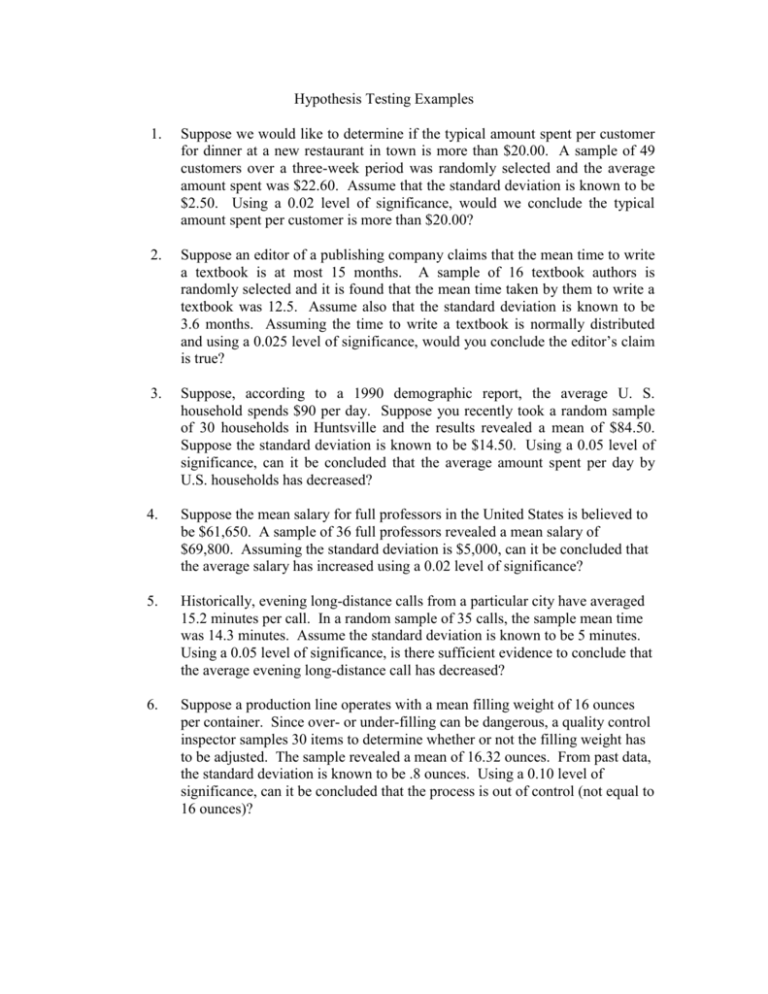
Hypothesis Testing Examples 1. Suppose we would like to determine if the typical amount spent per customer for dinner at a new restaurant in town is more than $20.00. A sample of 49 customers over a three-week period was randomly selected and the average amount spent was $22.60. Assume that the standard deviation is known to be $2.50. Using a 0.02 level of significance, would we conclude the typical amount spent per customer is more than $20.00? 2. Suppose an editor of a publishing company claims that the mean time to write a textbook is at most 15 months. A sample of 16 textbook authors is randomly selected and it is found that the mean time taken by them to write a textbook was 12.5. Assume also that the standard deviation is known to be 3.6 months. Assuming the time to write a textbook is normally distributed and using a 0.025 level of significance, would you conclude the editor’s claim is true? 3. Suppose, according to a 1990 demographic report, the average U. S. household spends $90 per day. Suppose you recently took a random sample of 30 households in Huntsville and the results revealed a mean of $84.50. Suppose the standard deviation is known to be $14.50. Using a 0.05 level of significance, can it be concluded that the average amount spent per day by U.S. households has decreased? 4. Suppose the mean salary for full professors in the United States is believed to be $61,650. A sample of 36 full professors revealed a mean salary of $69,800. Assuming the standard deviation is $5,000, can it be concluded that the average salary has increased using a 0.02 level of significance? 5. Historically, evening long-distance calls from a particular city have averaged 15.2 minutes per call. In a random sample of 35 calls, the sample mean time was 14.3 minutes. Assume the standard deviation is known to be 5 minutes. Using a 0.05 level of significance, is there sufficient evidence to conclude that the average evening long-distance call has decreased? 6. Suppose a production line operates with a mean filling weight of 16 ounces per container. Since over- or under-filling can be dangerous, a quality control inspector samples 30 items to determine whether or not the filling weight has to be adjusted. The sample revealed a mean of 16.32 ounces. From past data, the standard deviation is known to be .8 ounces. Using a 0.10 level of significance, can it be concluded that the process is out of control (not equal to 16 ounces)? Ho: μ = 20 Ha: μ > 20 1. Z x 22.60 20 7.28 2.50 n 49 Reject Ho if Z > 2.06 Reject Ho There is sufficient evidence to conclude the typical amount spent per customer is more than $20.00, α = 0.02. Ho: μ = 15 Ha: μ < 15 2. Z x 12.5 15 -2.78 3.6 n 16 Reject Ho if Z < -1.96 Reject Ho There is sufficient evidence to conclude the editor’s claim is true, α = 0.025. 3. Ho: Ha: Z x n μ = 90 μ < 90 84.50 90 -2.078 14.50 30 Reject Ho if Z < -1.65 Reject Ho There is sufficient evidence to conclude the average amount spent per day by U.S. households has decreased, α = 0.05. 4. μ = 61,650 μ > 61,650 Ho: Ha: Z x n 69,800 61,650 9.78 5,000 36 Reject Ho if Z > 2.06 Reject Ho There is sufficient evidence to conclude the average salary has increased, α = 0.02. 5. μ = 15.2 μ < 15.2 Ho: Ha: Z x 14.3 15.2 1.065 5 n 30 Reject Ho if Z < -1.65 Fail to Reject Ho There is insufficient evidence to conclude the average evening long-distance call has decreased, α = 0.05. 6. Ho: Ha: Z x n μ = 16 μ ≠ 16 16.32 16 2.19 0.8 30 Reject Ho if Z < - 1.65 OR Z > 1.65 Reject Ho There is sufficient evidence to conclude the process is out of control, α = 0.10.
